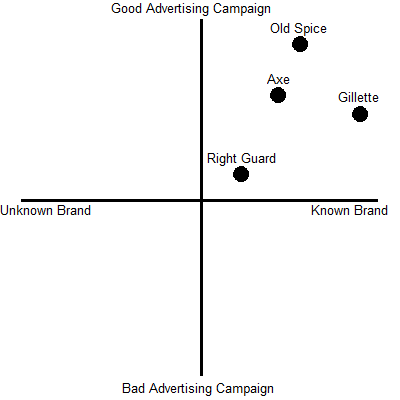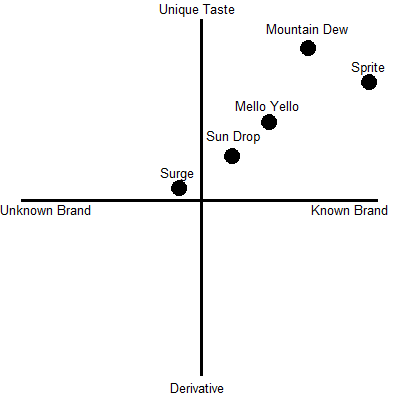Product Positioning is a marketing technique, aimed at finding best ways to introduce the target audiences to the products, and involves figuring out a message that will most likely reach them and stay with them. (Ries, Al, and Jack Trout 2).
Two brands of products will be assessed for their competition and attributes to better understand and refine positioning. The chosen products are Old Spice and Mountain Dew.
Old Spice, owned by Procter & Gamble, is an American brand of personal care products for men (“Old Spice SWOT Analysis, USP & Competitors”). Its products include shaving soaps, aftershave lotions, deodorants, body washes and body sprays. In the past, its target audience was 40-60 years old men, but it has shifted to younger men of 12 to 34 years old. Its competitors are Axe (a fast-growing newcomer to the market), Right Guard and Gillette (also brands owned by Procter & Gamble) (Newman).
Male grooming products are evaluated based on such attributes as brand familiarity, scent, functionality and advertising campaign. Brand familiarity is one of the main factors affecting product sales, as buyers are more likely to purchase familiar goods. Scent plays an important role, as it makes a product more recognizable and is what causes people to stick to a brand. Functionality covers how well the product protects from body odor, how pleasant it is on the skin, etc. And the advertising campaign is what introduces new audiences to the brands, raising their interest.
Mountain Dew is a carbonated soft drink, part of the PepsiCo’s array of products (“Mountain Dew SWOT Analysis, USP & Competitors”). Its target market is young people from 18 to 24. It competes with The Coca-Cola Company’s Sprite, its Mello Yello and Surge (introduced in response to Mountain Dew), and Sun Drop, produced by Dr. Pepper Snapple Group (Stanford and Duane).
Four important attributes can be distinguished with soft drinks: brand recognition, taste, nutritional value and advertising campaign. While brand recognition and ad campaign carry over from the male grooming products’ attributes, taste is one of the major parts of what defines a drink and distinguishes it from its competitors, and nutritional value determines the healthiness of the product.
Two-dimensional perceptual maps will be drawn up for both studied brands and their competitors to study product positioning, based on two of their attributes.
Old Spice and its competitors will be examined based on brand familiarity and advertising campaign.

For the target market of 12 to 34 years old young men, Old Spice is the best advertised among male grooming products.
Old Spice has recently had a successful advertising campaign that has brought it into the spotlight, but it is still a less known brand than Gillette. Axe has burst into the public view with their new ad campaign, but received criticism and backlash over it, and is still behind Gillette and Old Spice. Right Guard is the least known of the four and lacks a strong advertising campaign.
Mountain Dew and its competitors will be evaluated based on brand recognition and uniqueness of taste.
Sprite is more popular brand than Mountain Dew but tends to be seen as more interchangeable with some other brands, such as 7-Up, in terms of taste. Mello Yello and Surge are now getting a more attention due to revival efforts of
The Coca-Cola Company’s, but, similarly to Sun Drop, can’t contend with the market leaders and are seen as derivative (Ledbetter and Carly).

For young people from 18 to 24, Mountain Dew is the most unique tasting among all evaluated soft drinks.
If a new brand were to be launched, it would be wise to find a niche other products haven’t taken. In both scenarios, it would be smart to place it higher on the Taste or Advertising Campaign axis, to faster find its niche.
In conclusion, product positioning is extremely useful in a competitive market and is vital in determining the best course of action or directions of change.
Works Cited
Ledbetter, Carly. “We Tasted Surge Soda So You Don’t Have To.”The Huffington Post. TheHuffingtonPost.com, 2014. Web.
“Mountain Dew SWOT Analysis, USP & Competitors.” MBA Skool. N.p., n.d. Web.
Newman, Andrew Adam. “Bold Imagery to Play on a New Insecurity: Deodorant Aesthetics.”The New York Times. The New York Times, 2009. Web.
“Old Spice SWOT Analysis, USP & Competitors.”MBA Skool. N.p., n.d. Web.
Ries, Al, and Jack Trout. Positioning: The Battle for Your Mind. New York: McGraw-Hill Education, 2001. Print.
Stanford, Duane. “Mountain Dew Wants Some Street Cred.”Bloomberg. N.p., 2012. Web.